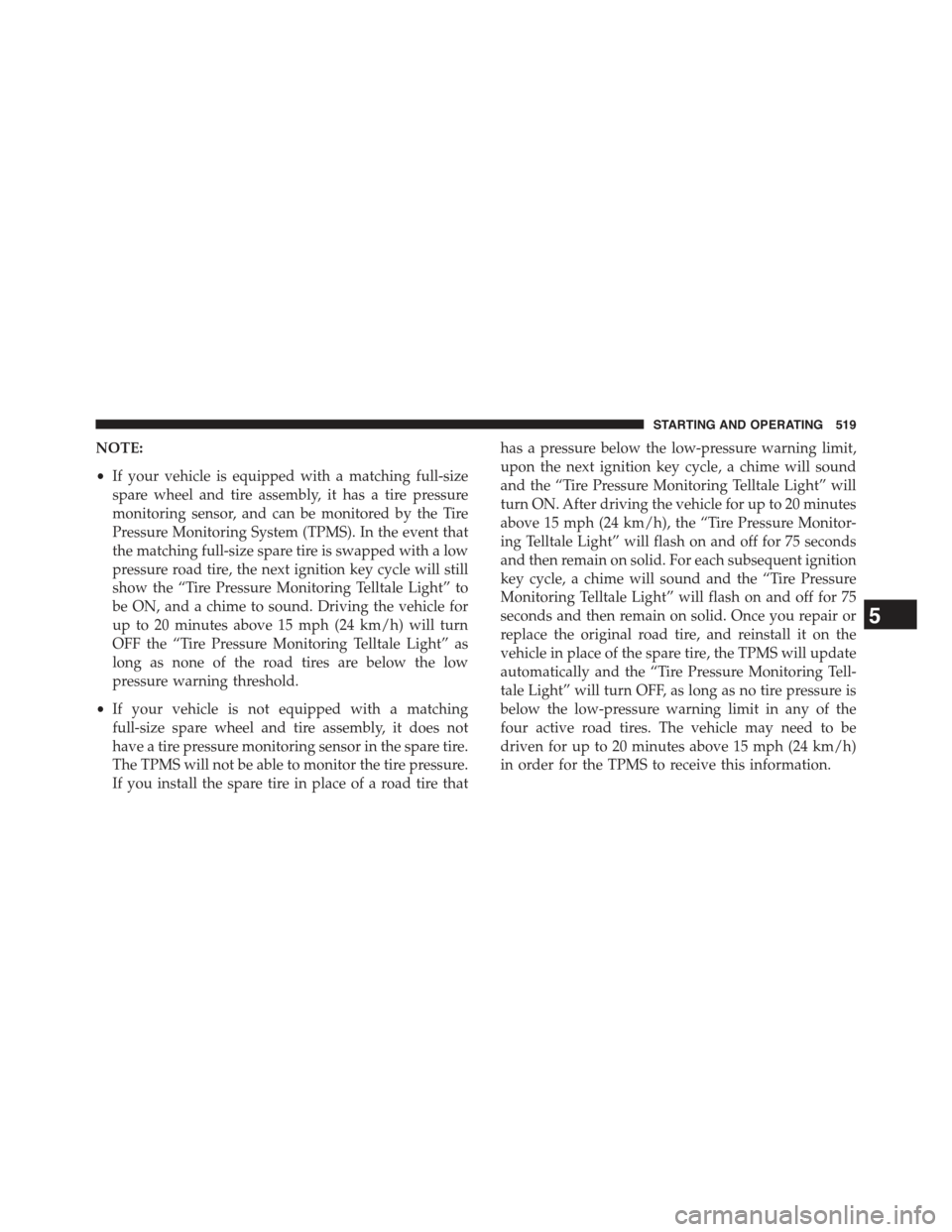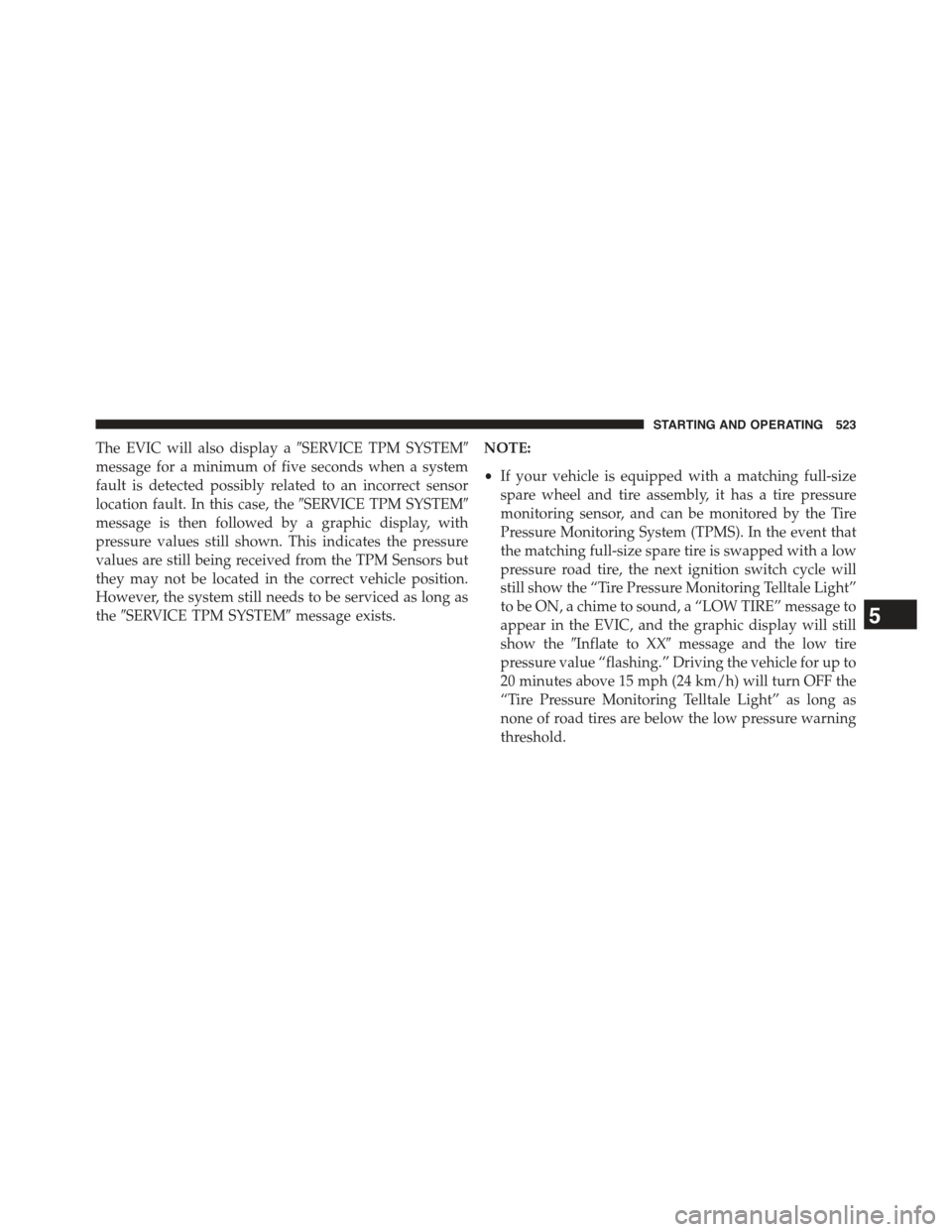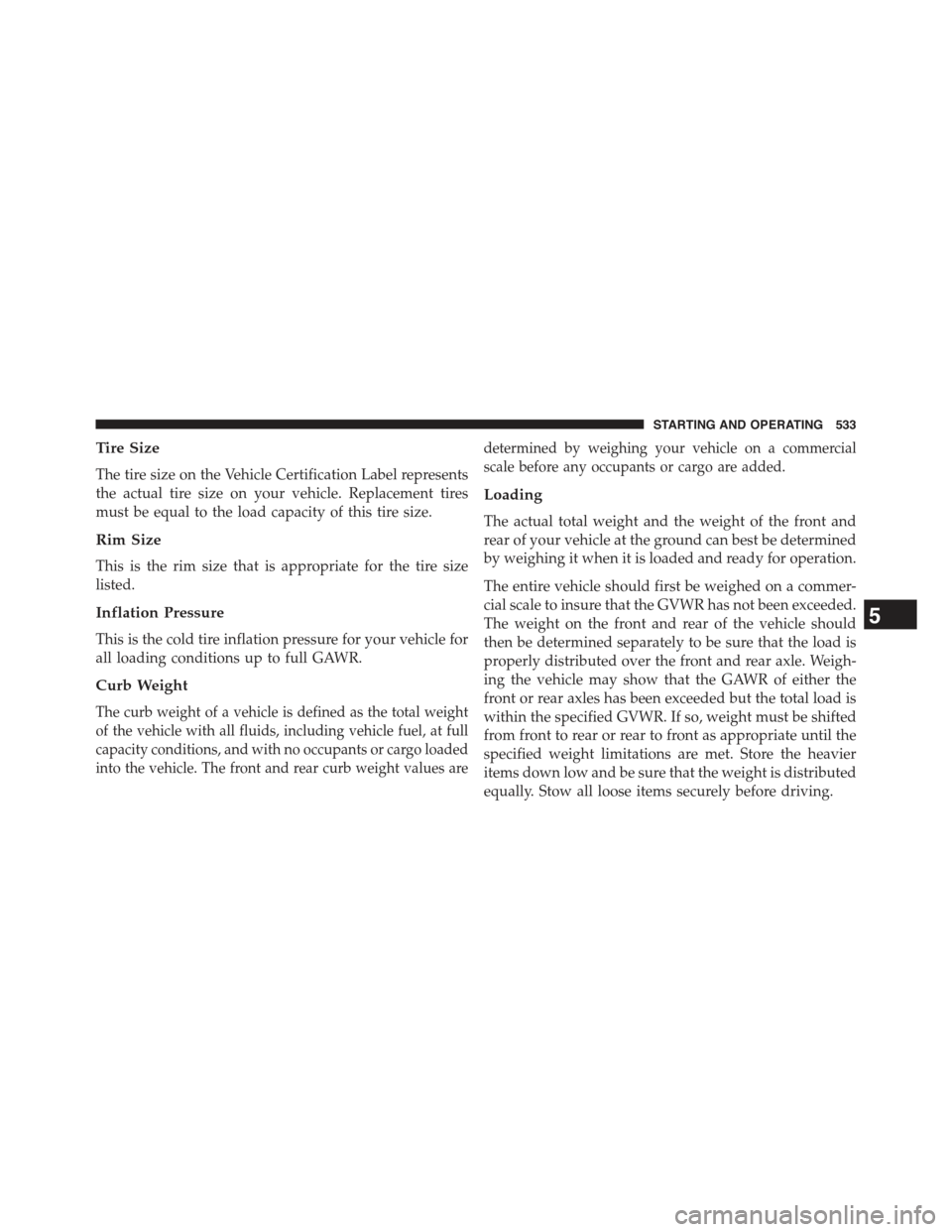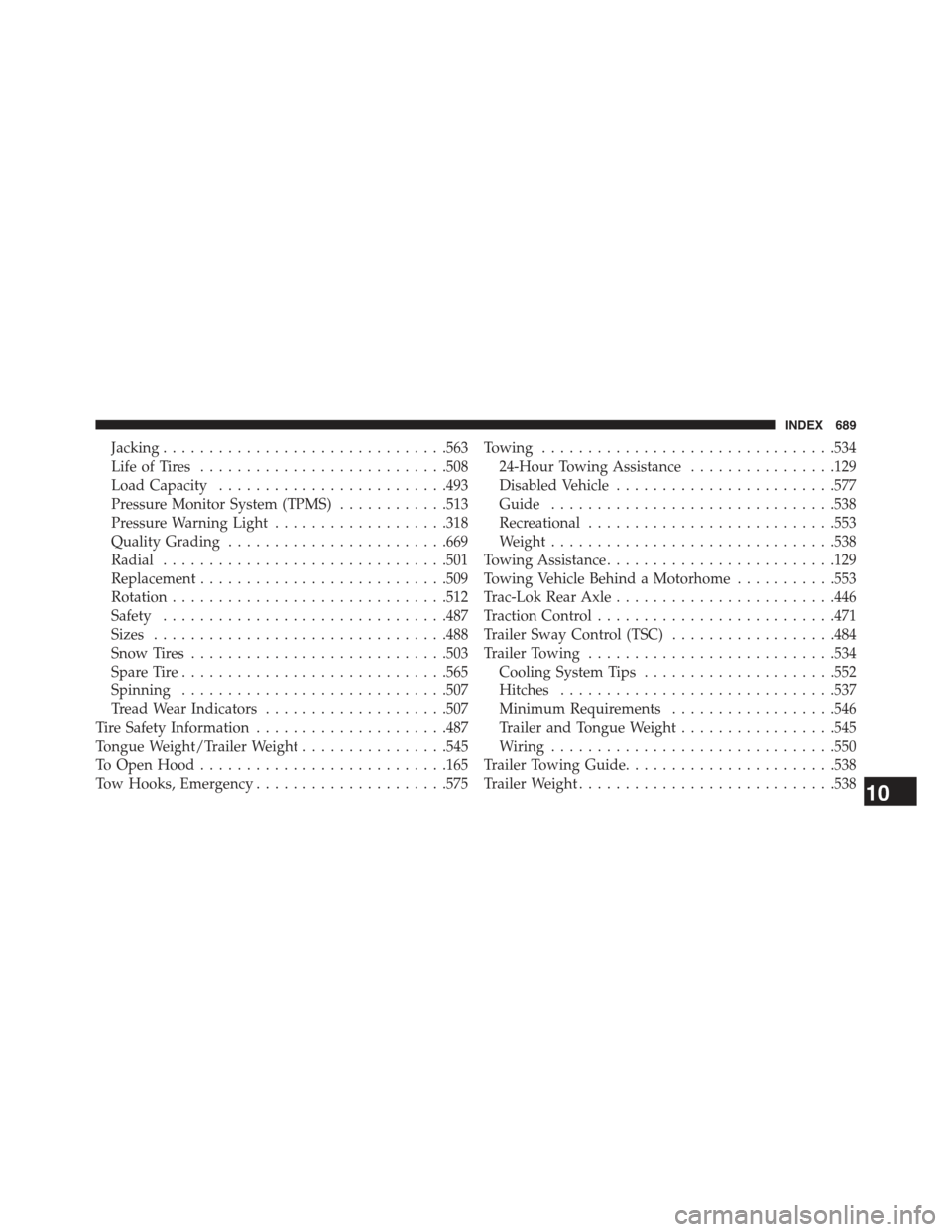tire size JEEP WRANGLER 2015 JK / 3.G Owner's Manual
[x] Cancel search | Manufacturer: JEEP, Model Year: 2015, Model line: WRANGLER, Model: JEEP WRANGLER 2015 JK / 3.GPages: 695, PDF Size: 20.64 MB
Page 521 of 695

NOTE:
•If your vehicle is equipped with a matching full-size
spare wheel and tire assembly, it has a tire pressure
monitoring sensor, and can be monitored by the Tire
Pressure Monitoring System (TPMS). In the event that
the matching full-size spare tire is swapped with a low
pressure road tire, the next ignition key cycle will still
show the “Tire Pressure Monitoring Telltale Light” to
be ON, and a chime to sound. Driving the vehicle for
up to 20 minutes above 15 mph (24 km/h) will turn
OFF the “Tire Pressure Monitoring Telltale Light” as
long as none of the road tires are below the low
pressure warning threshold.
•If your vehicle is not equipped with a matching
full-size spare wheel and tire assembly, it does not
have a tire pressure monitoring sensor in the spare tire.
The TPMS will not be able to monitor the tire pressure.
If you install the spare tire in place of a road tire that
has a pressure below the low-pressure warning limit,
upon the next ignition key cycle, a chime will sound
and the “Tire Pressure Monitoring Telltale Light” will
turn ON. After driving the vehicle for up to 20 minutes
above 15 mph (24 km/h), the “Tire Pressure Monitor-
ing Telltale Light” will flash on and off for 75 seconds
and then remain on solid. For each subsequent ignition
key cycle, a chime will sound and the “Tire Pressure
Monitoring Telltale Light” will flash on and off for 75
seconds and then remain on solid. Once you repair or
replace the original road tire, and reinstall it on the
vehicle in place of the spare tire, the TPMS will update
automatically and the “Tire Pressure Monitoring Tell-
tale Light” will turn OFF, as long as no tire pressure is
below the low-pressure warning limit in any of the
four active road tires. The vehicle may need to be
driven for up to 20 minutes above 15 mph (24 km/h)
in order for the TPMS to receive this information.
5
STARTING AND OPERATING 519
Page 522 of 695

Premium System — If Equipped
The Tire Pressure Monitor System (TPMS) uses wireless
technology with wheel rim-mounted electronic sensors to
monitor tire pressure levels. Sensors, mounted to each
wheel as part of the valve stem, transmit tire pressure
readings to the Receiver Module.
NOTE:It is particularly important, for you to regularly
check the tire pressure in all of your tires and to maintain
the proper pressure.
The Tire Pressure Monitor System (TPMS) consists of the
following components:
•Receiver Module
•Four Tire Pressure Monitoring Sensors
•Various Tire Pressure Monitoring System Messages,
which display in the Electronic Vehicle Information
Center (EVIC), and a graphic displaying tire pressures
•Tire Pressure Monitoring Telltale Light
A tire pressure monitoring sensor is located in the spare
wheel, if the vehicle is equipped with a matching full-size
spare wheel and tire assembly. The matching full-size
spare tire can be used in place of any of the four road
tires.Tire Pressure Monitor Display
520 STARTING AND OPERATING
Page 525 of 695

The EVIC will also display a#SERVICE TPM SYSTEM#
message for a minimum of five seconds when a system
fault is detected possibly related to an incorrect sensor
location fault. In this case, the#SERVICE TPM SYSTEM#
message is then followed by a graphic display, with
pressure values still shown. This indicates the pressure
values are still being received from the TPM Sensors but
they may not be located in the correct vehicle position.
However, the system still needs to be serviced as long as
the#SERVICE TPM SYSTEM#message exists.
NOTE:
•If your vehicle is equipped with a matching full-size
spare wheel and tire assembly, it has a tire pressure
monitoring sensor, and can be monitored by the Tire
Pressure Monitoring System (TPMS). In the event that
the matching full-size spare tire is swapped with a low
pressure road tire, the next ignition switch cycle will
still show the “Tire Pressure Monitoring Telltale Light”
to be ON, a chime to sound, a “LOW TIRE” message to
appear in the EVIC, and the graphic display will still
show the#Inflate to XX#message and the low tire
pressure value “flashing.” Driving the vehicle for up to
20 minutes above 15 mph (24 km/h) will turn OFF the
“Tire Pressure Monitoring Telltale Light” as long as
none of road tires are below the low pressure warning
threshold.
5
STARTING AND OPERATING 523
Page 526 of 695

•If your vehicle is not equipped with a matching
full-size spare wheel and tire assembly, it does not
have a tire pressure monitoring sensor in the spare tire.
The TPMS will not be able to monitor the tire pressure.
If you install the spare tire in place of a road tire that
has a pressure below the low-pressure warning limit,
upon the next ignition switch cycle, the “Tire Pressure
Monitoring Telltale Light” will remain ON, a chime
will sound, and the EVIC will still display the#Inflate
to XX#message and a “flashing” pressure value in the
graphic display. After driving the vehicle for up to 20
minutes above 15 mph (24 km/h), the “Tire Pressure
Monitoring Telltale Light” will flash on and off for 75
seconds and then remain on solid. In addition, the
EVIC will display a “SERVICE TPM SYSTEM#mes-
sage for a minimum of five seconds and then display
dashes (- -) in place of the pressure value. For each
subsequent ignition switch cycle, a chime will sound,
the “Tire Pressure Monitoring Telltale Light” will flash
on and off for 75 seconds and then remain on solid,
and the EVIC will display a#SERVICE TPM SYSTEM#
message for a minimum of five seconds and then
display dashes (- -) in place of the pressure value.
•Once you repair or replace the original road tire, and
reinstall it on the vehicle in place of the spare tire, the
TPMS will update automatically.
In addition, the “Tire Pressure Monitoring Telltale Light”
will turn OFF and the graphic in the EVIC will display a
new pressure value instead of dashes (- -), as long as no
tire pressure is below the low-pressure warning limit in
any of the four active road tires. The vehicle may need to
be driven for up to 20 minutes above 15 mph (24 km/h)
in order for the TPMS to receive this information.
524 STARTING AND OPERATING
Page 535 of 695

Tire Size
The tire size on the Vehicle Certification Label represents
the actual tire size on your vehicle. Replacement tires
must be equal to the load capacity of this tire size.
Rim Size
This is the rim size that is appropriate for the tire size
listed.
Inflation Pressure
This is the cold tire inflation pressure for your vehicle for
all loading conditions up to full GAWR.
Curb Weight
The curb weight of a vehicle is defined as the total weight
of the vehicle with all fluids, including vehicle fuel, at full
capacity conditions, and with no occupants or cargo loaded
into the vehicle. The front and rear curb weight values are
determined by weighing your vehicle on a commercial
scale before any occupants or cargo are added.
Loading
The actual total weight and the weight of the front and
rear of your vehicle at the ground can best be determined
by weighing it when it is loaded and ready for operation.
The entire vehicle should first be weighed on a commer-
cial scale to insure that the GVWR has not been exceeded.
The weight on the front and rear of the vehicle should
then be determined separately to be sure that the load is
properly distributed over the front and rear axle. Weigh-
ing the vehicle may show that the GAWR of either the
front or rear axles has been exceeded but the total load is
within the specified GVWR. If so, weight must be shifted
from front to rear or rear to front as appropriate until the
specified weight limitations are met. Store the heavier
items down low and be sure that the weight is distributed
equally. Stow all loose items securely before driving.
5
STARTING AND OPERATING 533
Page 563 of 695

NOTE:There are steps that you can take to slow down
an impending overheat condition:
•If your air conditioner (A/C) is on, turn it off. The A/C
system adds heat to the engine cooling system and
turning the A/C off can help remove this heat.
•You can also turn the temperature control to maximum
heat, the mode control to floor and the blower control
to high. This allows the heater core to act as a
supplement to the radiator and aids in removing heat
from the engine cooling system.
WARNING!
You or others can be badly burned by hot engine
coolant (antifreeze) or steam from your radiator. If
you see or hear steam coming from under the hood,
do not open the hood until the radiator has had time
to cool. Never try to open a cooling system pressure
cap when the radiator or coolant bottle is hot.
WHEEL AND TIRE TORQUE SPECIFICATIONS
Proper lug nut/bolt torque is very important to ensure
that the wheel is properly mounted to the vehicle. Any
time a wheel has been removed and reinstalled on the
vehicle the lug nuts/bolts should be torqued using a
properly calibrated torque wrench.
Torque Specifications
Lug Nut/Bolt Torque **Lug Nut/
Bolt Size
Lug Nut/
Bolt Socket
Size
100 Ft-Lbs (135 N·m) 1/2” x 20 19 mm
**Use only Chrysler recommended lug nuts/bolts and
clean or remove any dirt or oil before tightening.
Inspect the wheel mounting surface prior to mounting
the tire and remove any corrosion or loose particles.
6
WHAT TO DO IN EMERGENCIES 561
Page 691 of 695

Jacking...............................563
Life of Tires...........................508
Load Capacity.........................493
Pressure Monitor System (TPMS)............513
Pressure Warning Light...................318
Quality Grading........................669
Radial...............................501
Replacement...........................509
Rotation..............................512
Safety...............................487
Sizes................................488
Snow Tires............................503
Spare Tire.............................565
Spinning.............................507
Tread Wear Indicators....................507
Tire Safety Information.....................487
Tongue Weight/Trailer Weight................545
To Open Hood...........................165
Tow Hooks, Emergency.....................575
Towing................................534
24-Hour Towing Assistance................129
Disabled Vehicle........................577
Guide...............................538
Recreational...........................553
Weight...............................538
Towing Assistance.........................129
Towing Vehicle Behind a Motorhome...........553
Trac-Lok Rear Axle........................446
Traction Control..........................471
Trailer Sway Control (TSC)..................484
Trailer Towing...........................534
Cooling System Tips.....................552
Hitches..............................537
Minimum Requirements..................546
Trailer and Tongue Weight.................545
Wiring...............................550
Trailer Towing Guide.......................538
Trailer Weight............................53810
INDEX 689